Ultimate Guide for Albino Algae Eater Fish
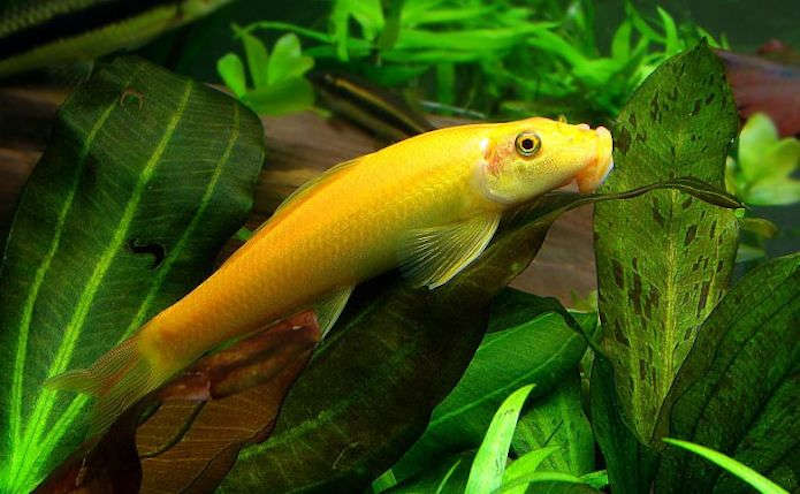
Discover everything you need to know about albino algae eater fish, from their unique appearance and behavior to detailed care tips and tank setup advice. Perfect for both novice and experienced aquarists, this ultimate guide will help you maintain a healthy and beautiful aquarium.
1. Overview of albino algae eater fish
The albino algae eater fish, known for its distinctive appearance and diligent algae-cleaning habits, is a popular choice among aquarium enthusiasts.
| Scientific name | Gyrinocheilus aymonieri |
| Common name | Albino algae eater or Chinese algae eater |
| Origin | Southeast Asia
Southern China |
| Lifespan | 5-10 years |
| Diet | Omnivore: Algae, worms, tropical flakes,… |
| Temperament | Semi-aggressive |
| Reproduction | Egg-laying |
| Care difficulty | Beginner |
The Gyrinocheilus aymonieri, commonly known as the Chinese Algae Eater or Albino algae eater, is a fascinating freshwater fish species native to Southeast Asia. Prized by aquarists for their algae-eating abilities and unique appearance, these fish can flourish for up to a decade in the right environment.
However, maintaining their health requires knowledge of potential issues and proper care practices. This comprehensive guide will delve into the size and appearance, natural habitat, behavior, diet, and essential care tips for keeping albino algae eater fish healthy and happy in your home aquarium.
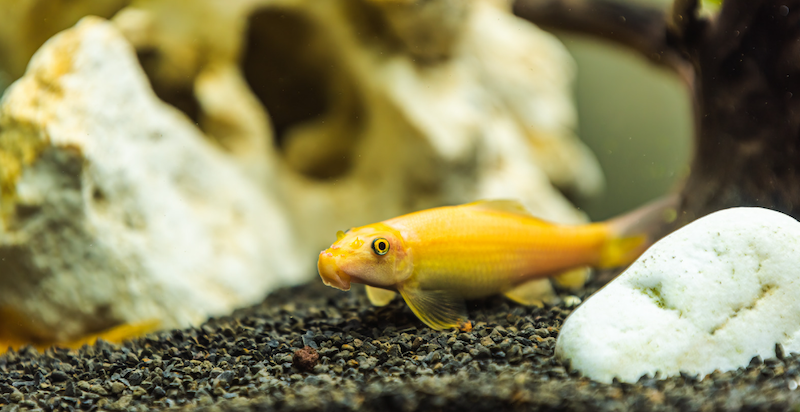
2. Appearance and behavior of albino algae eater fish
The Albino algae eater fish exhibits distinct characteristics in both appearance and behavior.
2.1. Appearance
- Color
The albino algae eater comes in two main color varieties: golden and brown.
Albino golden algae eaters are characterized by their striking golden-yellow bodies and bright red eyes. This unique coloration is due to a genetic mutation that inhibits melanin production, resulting in a lack of pigmentation.
The brown albino algae eater, also known as the Chinese algae eater, is a slightly less common variety. It has a light brown or tan body with a white or yellowish stripe running from its head to its tail. Its fins are also pale brown or white.

- Size
Albino algae eater size changes from juvenile to adult stages. When small, they typically measure around 3 – 4 cm (1.2 – 1.6 inches) in length.
How big do albino algae eaters get? Upon reaching adulthood, they grow to an average length of 25 – 28 cm (10 – 11 inches), though their size in captivity tends to be slightly smaller, around 15 cm (5.9 inches) within aquarium environments.
Interestingly, there are observable size differences between male and female specimens, with females often exhibiting larger dimensions than males, usually growing 2 – 3 cm (0.8 – 1.2 inches) longer.

- Physical Description
Albino algae eater fish possess a long, slender, and cylindrical body shape that is well-adapted for swimming and navigating aquatic environments, allowing them to maneuver through dense vegetation and explore various aquarium areas.

One of the most distinctive features of albino eater fish is their suction-style mouth, specially designed for consuming algae. This specialized mouth structure has rasping teeth, enabling the fish to effectively scrape algae off rocks, driftwood, and aquarium walls.
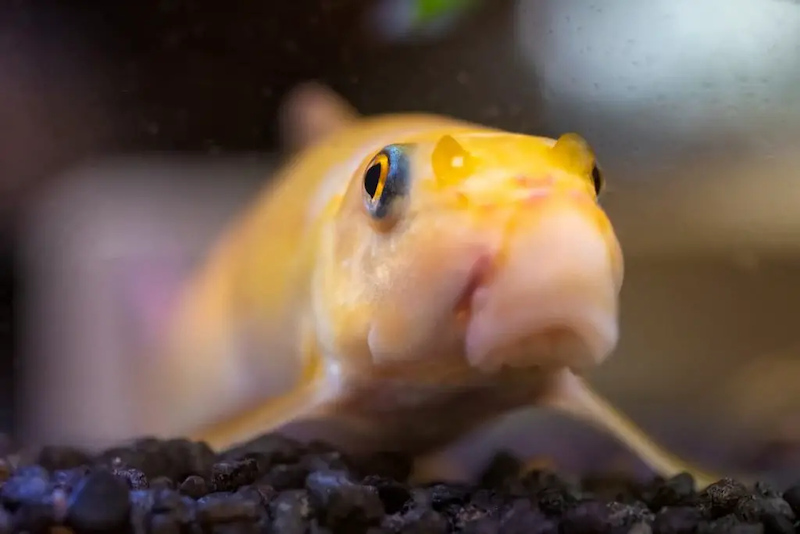
In addition to their unique mouth structure, this species also exhibits a prominent dorsal fin, a pair of pectoral fins, a pair of pelvic fins, and an anal fin. These fins are crucial in maintaining balance, steering, and propulsion during swimming.
2.2. Behaviour
Are Chinese algae eaters aggressive? They are generally peaceful, though they can become more aggressive as adults, especially when breeding.
Their notable behavior includes their algae-eating habits, often found grazing around rocks, at the bottom of tanks, or near the water surface to consume algae. This behavior is beneficial for controlling and reducing algae growth in aquariums. However, as they mature, their eating habits may change, and they may become less efficient at consuming algae compared to when they were younger.
They tend to thrive in groups, preferably of at least three individuals, to create a suitable environment and reduce stress among the fish. This group behavior helps maintain their well-being and social interactions within the tank environment.
3. Diet and Feeding
Albino algae eater fish primarily feed on algae and various aquatic plants. They are known to be nocturnal feeders, often actively feeding during the night. Their diet can include small organisms such as worms, detritus, and shrimp as they mature and become more efficient.
To ensure their nutritional needs during adulthood, it’s beneficial to supplement their diet with fresh vegetables 1-2 times per week. This helps to provide additional nutrients essential for their health and vitality.
Regarding feeding frequency, it’s recommended that they be fed daily. Feeding them at night and thawing frozen food before feeding to ensure they consume it easily and safely. Adequate nutrition for growth and well-being can be achieved through monitoring their feeding habits.
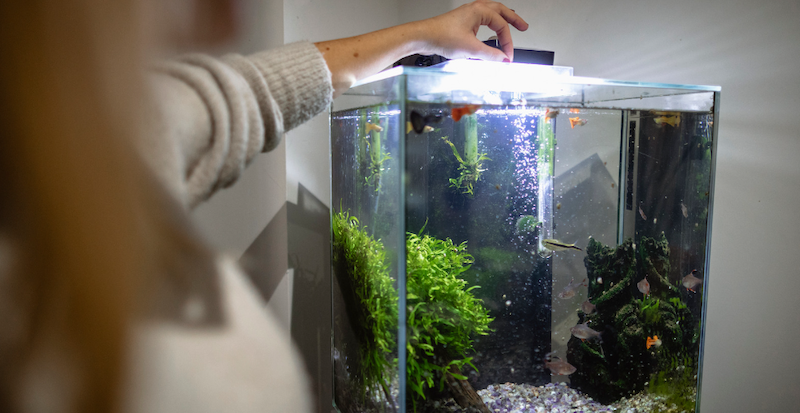
4. Recommended Tank Setup
Albino algae eater fish originate from Southeast Asia’s fast-flowing rivers and streams, where they prefer rocky areas with plenty of hiding places and vegetation. To create a suitable environment, consider the following factors before setting up their tank.
4.1. Tank setup
To replicate the natural environment of the albino algae eater fish in an aquarium, it’s essential to provide a spacious tank with a minimum capacity of 200 liters (53 gallons).
It’s important to create a setup that mimics their natural environment:
- Create substrate: Use small gravel or sand as the tank’s bottom layer.
- Provide ample hiding places: Incorporate rocks, gravel, artificial corals, and caves to mimic natural hiding spots. Albino algae eater fish tend to seek shelter.
- Create a riverine environment: Include live or artificial plants that resemble those found in riverbeds. This provides a sense of security for the fish and enhances water quality by promoting natural filtration.

4.2. Water quality
The Chinese algae eater is known for its hardiness but thrives best in well-maintained aquariums with specific water conditions:
- Temperature: Maintain water temperatures between 24 – 28 degrees Celsius (75 – 82 degrees Fahrenheit). This range mimics their natural habitat and supports their health.
- pH Level: Keep the pH level of the water around 6.0 – 7.5. This range is suitable for Chinese Algae Eaters and helps maintain overall water stability.
- Water hardness: They can adapt to a range of water hardness levels, but moderate hardness is generally preferred.
- Lighting: Provide moderate lighting in the aquarium. Avoid excessive light, as it can promote algae growth, which might not always be consumed by the fish.
- Filtration: Adequate filtration is essential to keep the water clean and oxygenated. Use a filtration system suitable for your tank size and ensure it provides ample mechanical and biological filtration.
- Algae Control: Though Albino algae eater fish consume algae, not all types are suitable for them. Regular maintenance and cleaning of the tank are necessary to control algae growth and ensure a healthy environment for the fish.
4.3. Tankmates
What fish can live with Chinese algae eaters? Albino algae eater fish can coexist with other peaceful species that can tolerate their potential territorial behavior. Some suitable tankmates include:
- Molly Fish
- Platies
- Zebra Danios
- Emperor Tetra
- Dwarf Gourami
- Tiger Barbs
These species generally occupy different aquarium levels and are known for their peaceful nature, which can complement the behavior of the Chinese algae eater. However, it’s important to avoid overcrowding the tank, as these fish need ample space to reduce aggression.
In contrast, avoid keeping albino algae eater fish with fin-nipping or aggressive fish, which can lead to stress and potential injury. These species are known for aggressive behavior or those that may compete directly for territory are not recommended. Examples include:
- Large Cichlids
- Aggressive Barbs (like Rosy Barbs)
- Some Species of Gourami (like the Three-Spot Gourami)
- Arowanas
These fish may provoke or stress the albino algae eater fish, disrupting their peaceful demeanor and potentially causing harm. Ensuring compatibility in terms of temperament and space requirements will promote a harmonious aquarium environment for all inhabitants.
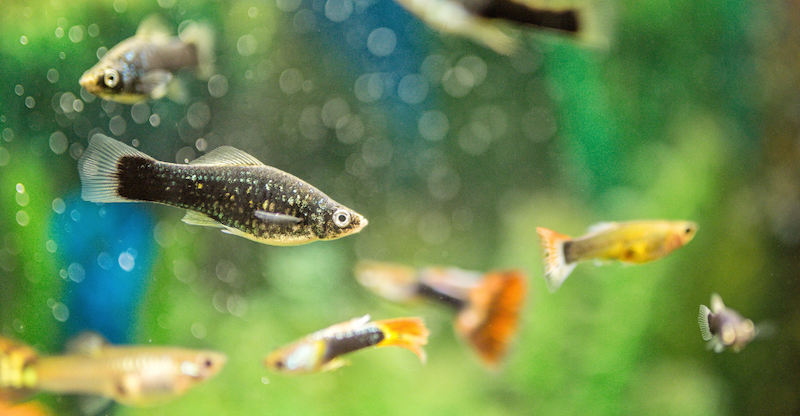
5. Health of albino algae eater fish
5.1. Healthy albino algae eater fish
Healthy albino algae eater fish are active and alert, with bright eyes and a clear body. They have a good appetite and are constantly grazing on algae or other food sources. Their fins are clean and undamaged, and they swim smoothly and gracefully. They also interact with their tank mates and explore their surroundings.
As Chinese algae eaters age, their health needs may change. Younger fish are more susceptible to diseases and parasites, while older fish may be more prone to organ degeneration and other age-related issues. It is important to provide your fish with the appropriate care at each stage of their life to help them live long and healthy lives.
The typical Chinese Algae Eater’s lifespan is around 10 years. However, with proper care, some individuals may live up to 15 years or more.
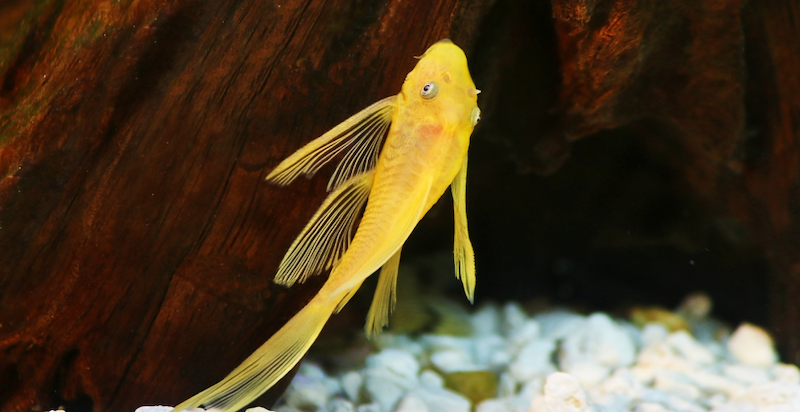
5.2. Common health issues
Despite their resilience, albino algae eater fish can still suffer from some common health issues, including: fungus, bacterial infections and cottonmouth/columnaris. By understanding the signs, causes, and treatments for these conditions, you can provide the best care for your algae eater.
- Fungus
Fungus appear as white fuzzy patches on the fish’s body or fins. It is often caused by poor water quality, stress, or injuries that create openings for fungal infections.
To treat fungus, you can improve water conditions with regular changes and maintain proper filtration. Use antifungal medications as directed to eliminate the fungus and prevent its spread among other fish.
- Bacterial infections
Bacterial infections can manifest as cloudy eyes, fin rot, or skin lesions. Stress, injuries, or compromised water quality typically trigger these infections.
Aquarium keepers can prevent bacterial infections in albino algae eater fish by maintaining clean water conditions and reducing stress factors. To halt the infection’s progression and support recovery, affected fish should be treated promptly with antibiotics or antibacterial medications prescribed by a veterinarian.
- Cottonmouth or columnaris
Columnaris, also known as Cottonmouth disease, manifests as whitish patches around the mouth or body, lethargy, and loss of appetite. This bacterial infection thrives in stressed fish due to poor water quality or physical injuries.
To prevent the spread of Columnaris, quarantine affected fish to prevent spreading, and antibiotics or other medications should be administered as a veterinarian recommends. You can also improve water quality through filtration and regular maintenance to minimize the risk of future infections and maintain the health of your albino algae eater fish.

6. FAQs
- What is the price of albino algae eater fish?
The price of albino algae eater fish (Chinese algae eaters) ranges from $5 to $20 per fish. However, it can vary depending on size, aquarium shops, and breeder.
- What’s the difference between Albino algae eater fish and Siamese algae eater?
Albino algae eater fish and Siamese algae eater fish are often mistaken due to their similar body shapes, elongated fins, and preference for algae as a food source. However, there are several key differences between the two species:
- Color: Albino algae eaters are pale with red eyes, while Siamese algae eaters have a black horizontal stripe and a red stripe along their body.
- Temperament: Albino algae eaters can become aggressive as adults, while Siamese algae eaters are generally peaceful.
- Size: Albino algae eaters grow larger by 25 – 28 cm (up to 10 – 11 inches) than Siamese algae eaters 15 cm (around 6 inches).
- How often should I clean the tank?
For a healthy aquarium with albino algae eaters, you should perform partial water changes (25-50%) weekly. Depending on the tank size and bioload, you might need more frequent cleanings.
In addition to water changes, tank cleaning typically needs to be done every 2 – 4 weeks, depending on algae growth. It is recommended to focus on removing algae buildup without disrupting the beneficial bacteria in the gravel and filter media.
- Care guide for Albino algae fish eater?
Here’s a quick care guide:
- Tank size: Minimum 53 gallons
- Water parameters: pH 6.0 – 7.5, water temperature 22 – 25°C (72 – 78°F)
- Diet: Algae wafers, vegetables, occasional live/frozen food
- Tank mates: Peaceful community fish (avoid fin nippers)
- Lifespan: Up to 10 years with proper care.
Whether you’re a seasoned aquarist or just starting out, albino algae eaters can be a valuable addition to your tank. Their algae-fighting abilities and interesting looks make them a popular choice. With the right care and tank setup, you can create a thriving environment for both your fish and your aquarium.



